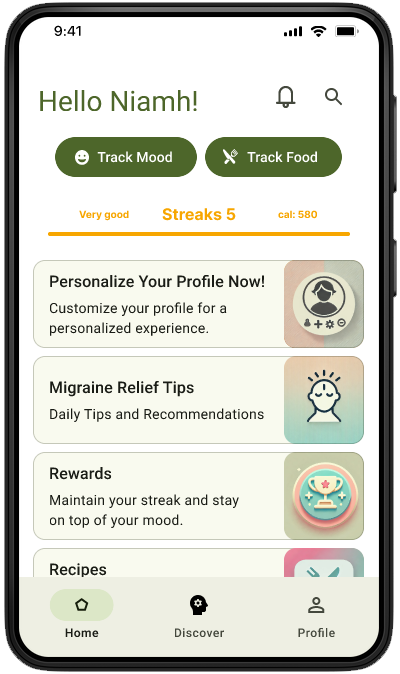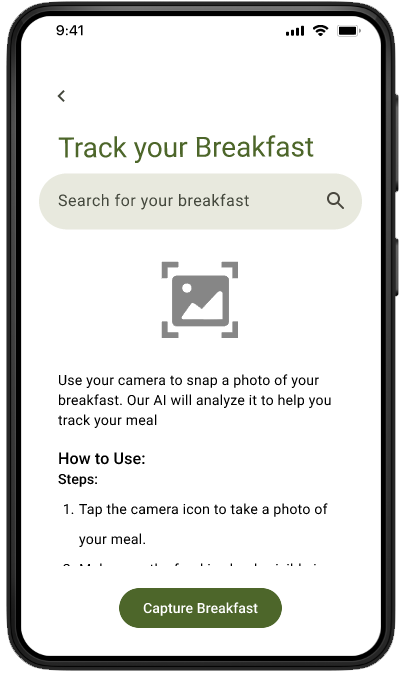Introduction
MoodBite is a mobile app I designed to provide personalized nutrition recommendations that enhance emotional well-being. With insights into mood-boosting foods and tailored nutrition advice based on medical and dietary needs, MoodBite empowers users to make informed choices that positively impact their mood and health.
A Project from Bronagh Linck Ryan
A Project from Bronagh Linck Ryan
Exploring Diet and Emotional Well-Being
In a world that moves quickly, the connection between what we eat and how we feel often gets overlooked. That’s where MoodBite steps in. I created this app to explore the link between food and mood, providing users with personalized dietary advice to boost their emotional health and help them feel their best.
User-Centric Design Approach
The design of MoodBite is rooted in real user feedback. I developed personas like Niamh, the "Gluten-Free Go-Getter," and Finn, the "Mindful Tech Wiz," to guide the design process. Their journeys informed key design decisions, helping me create an app that meets users where they are—whether they’re managing migraines through diet or understanding how dairy affects their mood.





Identifying the Need
The idea for MoodBite started with a simple observation: many people eat based on their emotions, which can often derail their health goals. As a UX/UI designer, I saw an opportunity to address this challenge by creating a tool that helps users understand the power of food in managing their mood. MoodBite provides personalized recommendations while also taking into account dietary restrictions and medical needs—turning healthy eating into a personalized experience that nurtures emotional well-being.
Challenges and Competitive Landscape
Competing in a space filled with apps like Lifesum and MyFitnessPal wasn't easy. My strategy was to set MoodBite apart by directly linking food to mood tracking. By focusing on the relationship between what we eat and how we feel, MoodBite differentiates itself from both diet-focused apps and mental wellness platforms.
User Journey Maps: Crafting Targeted User Experiences
These visual maps were crucial in designing for real-life scenarios. For example:
Niamh’s Journey: Highlighted the need for instant access to symptom tracking and dietary advice during migraine episodes.
Sara’s Journey: Showed the importance of quick, efficient interactions, leading to a streamlined dashboard.
Finn’s Journey: Inspired gamification features to engage a young, tech-savvy audience.



Impact on Design
These user journey maps directly influenced MoodBite’s design. They guided me in creating an app that not only functions well but also deeply connects with users' emotional states and daily routines. These insights ensure that MoodBite continues to evolve based on user feedback.
User flows
I developed user flows focused on distinct goals to enhance the app's utility and user experience. These flows ensure a seamless experience, from tracking migraines and mood to discovering stress-relieving recipes. By focusing on personalized journeys, MoodBite helps users effortlessly integrate healthy habits into their daily lives, making emotional well-being more accessible.



Mobile-First Design: Feature Adaptation Across Devices
MoodBite was designed with a mobile-first mindset, adapting seamlessly across devices like smartphones, tablets, and even smartwatches. This ensures that users like Niamh, Finn, and Kris can access the app’s features on the go, whether tracking mood, browsing recipes, or checking personalized health tips.

Sitemap
The sitemap shows MoodBite's streamlined structure, guiding users from onboarding to diverse features like mood tracking, recipes, activities, and profile settings. It ensures a user-friendly navigation experience across the app.
Low - fidelity
These low-fidelity wireframes showcase the foundational design concepts for MoodBite, focusing on basic layout and functionality to test ideas quickly and effectively.

Testing Process for MoodBite
To ensure the best user experience, I conducted thorough moderated and unmoderated testing and iterated based on feedback. Here are some key findings and solutions:
Cluttered Home Screen: Simplified navigation with clearer icons and labels.
Food-Mood Connection: Added a dashboard that visualizes the link between food and mood.
Inconsistent Visual Design: Standardized the color scheme for a more cohesive experience.
Privacy Concerns: Strengthened encryption and privacy settings.
Complex Onboarding: Streamlined the process with easier-to-follow menus and options.
These iterations, based on real user feedback, helped refine MoodBite into a more user-friendly, secure, and visually cohesive app.
Food-Mood Connection: Added a dashboard that visualizes the link between food and mood.
Inconsistent Visual Design: Standardized the color scheme for a more cohesive experience.
Privacy Concerns: Strengthened encryption and privacy settings.
Complex Onboarding: Streamlined the process with easier-to-follow menus and options.
These iterations, based on real user feedback, helped refine MoodBite into a more user-friendly, secure, and visually cohesive app.
High- fidelity
The high-fidelity screens present the vibrant and intuitive interface of MoodBite, an app designed to blend emotional well-being with healthy eating. MoodBite offers personalized dashboards that seamlessly integrate AI-powered food recognition, voice-activated mood tracking, and customized health tips. The app encourages users to build positive habits with daily streaks, rewards, and personalized insights, making healthy living both fun and accessible. Every interaction is designed to boost happiness and well-being in an engaging, user-friendly environment.














Next Steps
Looking ahead, the plan is to further refine the food-mood tracking system, enhance personalized meal plans, and continue improving the user experience. These updates will help MoodBite become the go-to app for managing emotional well-being through food.